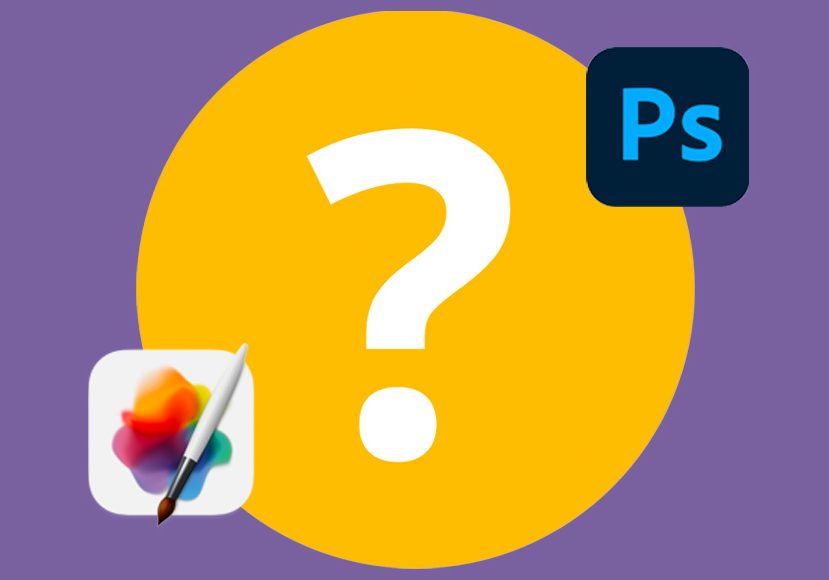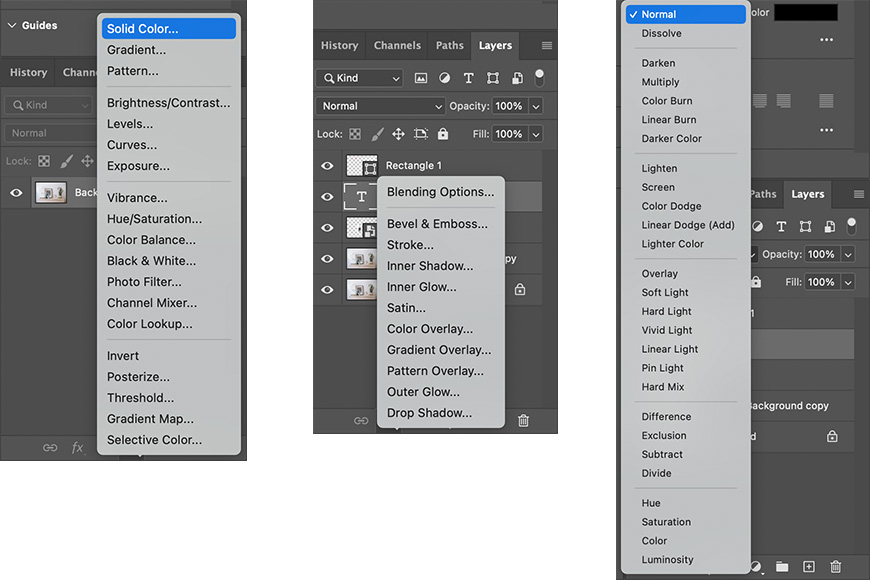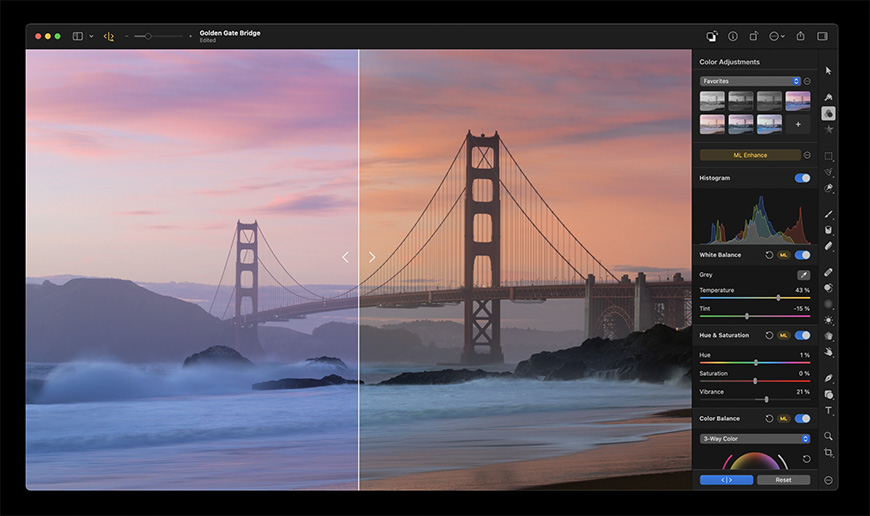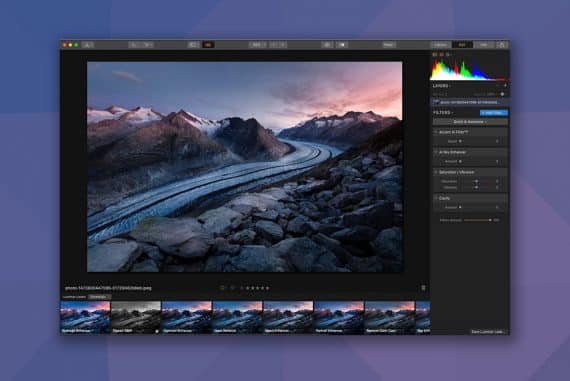
Pixelmator Pro vs. Photoshop (7 Key Differences)
Compare Pixelmator Pro and Photoshop to find out which graphic editing software reigns supreme in terms of features, ease of use, and value for money.
Photoshop | Software | By Jeff Collier
This Pixelmator Pro vs. Photoshop comparison will help you pick the best software for your needs.
Photoshop has been dominating the photo editing scene for years.
However, Pixelmator Pro has been challenging that throne with its cheaper price and updated features.
So, which one is better for you?
In this article, we’ll discuss all the key differences between the two programs.
We’ll also tell you about the best features of each photo editing software.
Keep reading to pick the one that suits your needs. Let’s jump into the details!
Table of Contents
Key Differences Between Pixelmator Pro and Photoshop
Let’s check out how Pixelmator Pro compares to Adobe Photoshop.
1. User Interface

Credit: Photomator website
Let’s kick things off with the first thing you’ll see once you open these tools: the interface.
Photoshop’s interface is slightly crowded with many features, which can be overwhelming.
On the other hand, Pixelmator Pro is more streamlined and beginner-friendly.
The simplicity of the interface makes it easier to work without sacrificing any capabilities.
Yet, for many people, Pixelmator Pro’s interface is too minimal and boring. It feels like a big, empty rectangle of a dark gray workspace.
Nonetheless, you can reach any tool you want by simply moving your mouse to the right. The motion of the list creates an appealing tactile experience.
Unlike Photoshop, you can’t change the theme of the tool. So, you’ll always be stuck with the dark gray theme.
Photoshop allows you to change the default theme to black, white, or medium gray.
2. Layer Options

Adobe Photoshop Adjustment Layers, Layer Styles, and Layer Blending Modes.
Layers allow you to do a lot of tasks, from simple things like adding text to your image to more complex ones like using a drop shadow.
With Photoshop, you’ll be able to use layer styles with thumbnails in a wide range of sizes. You can also add masks or clip layers visually.
Photoshop offers tons of features, like making non-destructive adjustments to the tones and colors of the pictures.
So, you’ll be able to edit the layers without permanently changing the pixels in your images.
On the other hand, with Pixelmator Pro, you can choose to work with no visible layer, a thumbnail view, or a list view.
While Pixelmator Pro has limited options, it offers a few unique layer tricks.
For example, the software uses machine learning to name layers.
You won’t believe how much time this auto-naming feature will save you. Of course, it’s not a perfect feature, as it doesn’t always detect the right objects in your photos.
Luckily, you can control-click any layer to check for other possible names.
One of the most disappointing downsides of Pixelmator Pro is that it doesn’t allow you to create layer adjustments that affect all the layers below.
For instance, if you need to convert your image into black-and-white, you’ll have to flatten the image or apply the black-and-white changes to every single layer.
In addition, unlike Photoshop, Pixelmator Pro doesn’t have a history palette.
So, if you’ve changed your mind about certain edits, you won’t be able to go through past versions of your image.
3. Editing Tools

Credit: Photomator website
Adobe Photoshop is the industry standard when it comes to editing tools. It has every tool you need, and you just have to learn how to use it.
Recently with the advent of AI, Photoshop has leapt forward in terms of what it can offer.
Generative AI Fill and Generative AI Expand are two such AI photo tools that can do amazing things to images in a couple of clicks.
Pixelmator Pro offers the usual suite of editing tools, including vector shapes, selection, and pixel repair.
While these tools aren’t as complex as Photoshop’s, they can get the job done.
The software has a feature called Recipes, which is similar to Adobe Lightroom’s presets.
This feature allows you to make certain adjustments to your images and save them as a “recipe.” Then, you can apply these presets to other images.
Pixelmator Pro also offers AI-powered selective adjustments but lacks the intricacies of Photoshop’s neural filters.
When it comes to popular photo repair tools, both applications have all the traditional things like red-eye remover and patching.
Nevertheless, when using the repair tool to remove parts from your image, each program does it a little differently.
In general, Photoshop will provide you with a greater variety of results.
4. Pricing

As of 2023, Adobe has three different plans that include Photoshop. You can get the basic Photoshop plan for a monthly fee of around $20, including a seven-day free trial.
There’s also the popular Adobe Photography Plans, which include Adobe Lightroom with Photoshop.
You can also go for the premium plan, which includes more than 20 desktop and mobile Adobe apps, like Photoshop, Lightroom, and Premiere Pro.
This plan will cost you more than $50 per month. On the other hand, you can buy Pixelmator Pro for a cheap one-time fee.
Buying Pixelmator Pro will cost you less than two months of a Photoshop subscription. That makes it a much more affordable alternative to Photoshop.
5. Operating System
Adobe Photoshop is available on most operating systems, such as Windows, Mac, and Linux. You can even use the software digitally on the web.
Unfortunately, Pixelmator Pro is only available for Mac devices. If you want to use the software on Windows, you’ll have to use a Mac emulator, which is a hassle.
6. Target Audience and Learning Curve
With its simple interface and easy-to-use tools, Pixelmator is perfect for beginners and amateur photo editors. It might also be a good option for part-time professionals.
However, full-time photo editors won’t be satisfied with this software. It lacks a lot of professional editing tools that they might need.
On the other hand, Adobe Photoshop is perfect for professional editors. Yet, there’s a steep learning curve for beginners.
Nonetheless, there are tons of free Photoshop tutorials available on the internet.
7. Application Support
Adobe Photoshop supports various applications, meaning you can export your images to other tools like Illustrator and Lightroom.
Unfortunately, you can only export Pixelmator Pro files to your Macbook, although you can still optimize them for the web.
Is Pixelmator Pro the Right Option for You?
You can think of Pixelmator Pro as a lite version of Adobe Photoshop at an affordable price. It contains almost any tool an amateur user would need.
That includes layers with masks, blending modes, tools for drawing, auto exposure, layer adjustments, and so on.
The interface is simple, and the tools are fairly easy to use. You won’t have a hard time navigating through the software.
That makes it perfect for beginners, students, and occasional designers. Yet, it won’t satisfy the needs of a professional photo editor.
On the bright side, Pixelmator’s developers are constantly adding new features to the software.
However, they aren’t trying to recreate every Photoshop feature, which is a good thing.
One of the best things about Pixelmator’s developers is that they’re trying to harvest the power of AI in any way possible.
Their AI background removal tool is incredible. Additionally, the ML Super Resolution uses machine learning to magnify photos with low resolution, which is pretty impressive.
Pros and Cons of Pixelmator Pro
Let’s check out some of the pros and cons of Pixelmator Pro.
Pros
Here are some of the pros that make Pixelmator Pro a great editing software:
- Ease-of-use: The program is minimal and super easy to use for someone with no editing experience.
- Value for money: Pixelmator Pro offers great value for money, as you pay a cheap one-time fee for this software rather than a monthly subscription.
- Fast: The application is fully optimized for Macs.
- AI tools: Pixelmator Pro has many AI tools that will make your editing process much easier.
Cons
Here are some of the downsides of Pixelmator Pro:
- Only available for Mac: You can’t use this software on Windows.
- Doesn’t have all the tools: Professionals might not find all the tools they need in this program.
Is Adobe Photoshop the Right Option for You?
Many professionals believe that Adobe Photoshop is the best image editor in the industry, and I couldn’t agree more.
However, it can take a lot of learning to master this beast of a photo editing software.
The application has tons of useful features that can make your work much easier.
For example, Adobe Creative Cloud allows you to access over one million photos, drawings, videos, and fonts.
In addition, with cross-platform editing, you can edit your images on the go!
However, before downloading Photoshop, you have to consider the pricey subscription.
Pros and Cons of Adobe Photoshop
Let’s explore the pros and cons of Adobe Photoshop.
Pros
- Unparalleled features: Adobe Photoshop has a wide range of features that receive constant updates
- No limit: The possibilities are endless with Photoshop. You can create anything from scratch.
- Easy transfer: You can easily transfer files between different applications.
- Access to Creative Cloud: With access to Creative Cloud, you’ll have countless materials you can use in your designs.
Cons
Here are some things you need to consider before choosing Photoshop:
- Pricey: You’ll have to pay a monthly subscription to use the software.
- Complexity: There’s a big learning curve to using Photoshop.
Should You Make the Switch from Photoshop to Pixelmator Pro?
If you’ve already been working with Adobe Photoshop, you’ll find it challenging to switch to Pixelmator Pro.
That’s mainly because of the different interfaces.
However, from a cost-saving perspective, switching from Photoshop to Pixelmator Pro will free you up from a monthly subscription fee.
Switching from Pixelmator to Photoshop is even more complicated.
Overall, switching from one software to another will affect your workflow, especially if you use shortcuts a lot.
It’ll take you a long time to relearn the new interface. Additionally, it can be frustrating when a certain feature you like is missing from the other software.
Therefore, if you’re already familiar with one software, you shouldn’t move to another one unless you have to.












